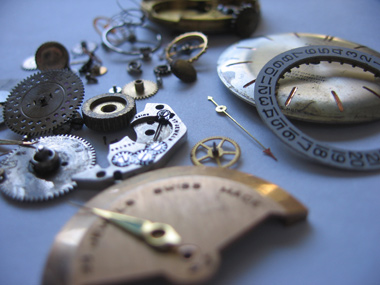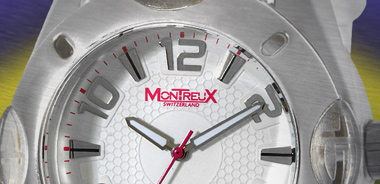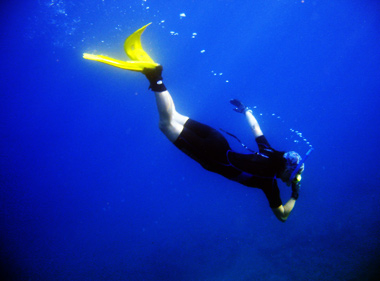
MonTreuX Watch Frequently Asked Questions
What do I need to do to keep my MonTreuX watch running for as long as possible?
 It is important to periodically service a watch to ensure that the components are well-lubricated, and that the mechanism is free from dust, dirt, and moisture. Any water that
gets inside a mechanical watch will wreak havoc with the precision mechanism inside, especially the anchor escapement and escape wheel which are typically made of steel.
It is important to periodically service a watch to ensure that the components are well-lubricated, and that the mechanism is free from dust, dirt, and moisture. Any water that
gets inside a mechanical watch will wreak havoc with the precision mechanism inside, especially the anchor escapement and escape wheel which are typically made of steel.
The typical rule of thumb is to have the water resistance (i.e., the integrity of the seals in the crown, bezel, and caseback) of a watch checked every year or so, especially if used for sports or diving. With the development of modern synthetic lubricants, most manufacturers recommend a servicing every four or five years.
What is a chronograph watch?
A chronograph is a watch that tells the time of day and also allows the user to time events of short-to-medium durations (i.e. from a few seconds to a few hours, typically). This is usually done in a mechanical watch through the central seconds hand, and one or more subdials (the regular, or continuous seconds, is also located on a dial). Chronographs are of varying usefulness, and are an interesting complication to put on a watch, as they often give the watch a sporty image.
A typical modern chronograph is operated with two pushers: one to start and stop the timing, and a second to reset the hands to zero when the timing is stopped. (In some older chronos with only one-button for control, the sequence of pushes was start-stop-reset - there was no provision to continue timing once the mechanism was stopped.)
What is a watch complication?
A complication is defined as a wristwatch function beyond that required for simple hour, minute, and second. More practically, common additions such as a day/date window are typically excluded from this definition. This leaves a wide variety of features that can be either commonly or less frequently found on watches.
What's the difference between top crystals?
An acrylic watch crystal (i.e. the see-through window above the dial) is a kind of plastic, which has the advantage of being resistant to shattering, but can be scratched easily. Fortunately, scratches can be easily removed from acrylic.
Mineral crystal is a kind of glass, which is more scratch resistant than acrylic, but not as as good as sapphire. Mineral crystals are also somewhat better at shatter resistance compared with sapphire. Unlike acrylic, scratches in mineral glass are more difficult to buff out; and unlike sapphire, mineral glass will scratch.
A sapphire crystal is indeed made of synthetic sapphire, which is a transparent form of corundum, or aluminum oxide (Al2O3). It is extremely hard (Moh's scale 9), and will resist scratching by most substances short of diamonds. However, if struck sharply and from the correct direction, sapphire will shatter. Despite the relatively large size compared with sapphire gemstones, sapphire crystals aren't very expensive (~$20). (Another fun fact - the windows built in to grocery store checkout lines which scan for the bar code on products are often made of synthetic sapphire - for the same reasons that watch crystals are!)
How can I remove minor scratches from my stainless steel MonTreuX watch?
 There is no universal way to repair, clean, or polish all SS surfaces: you must use different methods for different finishes. They are not without risk, the only safe way
being to send the watch to a jeweler. But if you are adventurous and persistent, the results can be very rewarding.
There is no universal way to repair, clean, or polish all SS surfaces: you must use different methods for different finishes. They are not without risk, the only safe way
being to send the watch to a jeweler. But if you are adventurous and persistent, the results can be very rewarding.
POLISHED SS
- For fine scratches, I've found that nothing beats a jeweler's cloth, like the Pioneer/Shino Polishing Cloth available from most watch suppliers for $3.60. It is a double cloth. The inner cloth is impregnated with a red polishing powder (ferric oxide or rouge, i.e., your common rust). The outer cloth protects your hand from the nasty red stain and is also used to give the final polish. This jeweler's polishing cloth works even better on gold. You may also use Sylvet washable or the double sided jewelers cloth typically sold in drug stores. The only other tools you need are elbow grease and common sense.
- For deep scratches, use Never-Dull--great name, isn't it?--usually sold in drug stores and hardware stores. Never-Dull is cotton impregnated with a strong cleaner/polisher. It has an unpleasant smell (like the polishing compound for cars) but works fast, leaving behind only faint scratches that can be removed with a jeweler's cloth. And presto, you've got a mirror finish! Well, not quite.
- CAVEAT: You will always leave microscopic scratches on a highly polished SS (or gold) surface. These ultra-fine scratches are visible only in bright light and from a certain angle. The only perfect finish I've seen is a factory finish. Even jobs done by jewelers are still inferior to the factory mirror finish. I don't know why.
BRUSHED SS
- To remove fine scratches, use a jeweler's cloth. Be GENTLE or you will put a shine on the finish, which will not quite match the brushed look. If that happens, you can put the brushed finish back on by following Step 3 below.
- For scratches over a small area, use a fiber-glass brush (e.g. the German-made Eurotool sold by watch-tool suppliers). It looks like a mechanical pencil with a bundle of glass fibers instead of lead that can be dispensed from the tip. You brush this glass-fiber tip on the SS surface to remove the scratches and to create a new brush finish. I would not recommend using this tool over a large area because the brush strokes tend to be uneven, especially around curves, though you can get better with practice. WARNING: The broken fiber glass on your skin can cause unpleasant itches. Wear a thin latex glove and use a brush to remove fiber-glass debris from your watch after repair.
- For scratches over a large area, use a Styrofoam block made for polishing finger nails (sold in beauty supply store). Each block is about an inch thick and 3 inches long. Its surface is impregnated with a very fine abrasive material. Brush gently with the grain to remove the scratches and to blend the new brush strokes with the original ones. I prefer this Styrofoam block to sand paper or steel wool as it is easy to grip and to maneuver. The soft Styrofoam also conforms to curved surfaces and is very forgiving. With patience, you can even remove deep dents and reshape small parts safely with this Styrofoam polisher.
How does "IP" or ion plating work?
Ion plating is one of the most advanced surface finishing processes in the trade. In traditional processes, the coating on the surface of the case can be rubbed off easily. Ion plating makes the metal plating more durable, more wear resistant, and also has a higher brightness. Ion plating involves adding of a titanium nitride layer, which has a high chemical stability, to the component to be plated. To this is added a metal (ex: gold, rose gold, or color) coating, normally not exceeding 0.3 urn in thickness. At low pressure-one thousandth of mercurial pressure-solid metal vaporizes and becomes electric ions when heated and bombarded by electrons, known also as plasma. Accelerated by a magnetic field, ion plating is carried out in a vacuum environment.
The greatest advantage of this process is that the titanium nitride produced is both harder and chemically more stable than that produced through traditional plating methods. Experiments have proved that the plating obtained through Ion plating is five to eight times better than that obtained through traditional methods in terms of wear and corrosion resistance. The term "permanent coating" can be appropriately applied in this case.
What does it mean when my MonTreuX watch is water resistant?
| ATM | METERS | FEET | USAGE |
| 3 | 30 | 100 | Suitable for everyday use. Splash/rain resistant. NOT suitable for showering, bathing, swimming, snorkeling, water related activities. |
| 5 | 50 | 165 | Suitable for swimming, white water rafting, non-snorkeling water related activities. |
| 10 | 100 | 330 | Suitable for recreational surfing, swimming, snorkeling, sailing and water sports. |
| 15 | 150 | 500 | Suitable for recreational surfing, swimming, snorkeling, sailing and water sports. |
| 20 | 200 | 660 | Suitable for professional marine activity and serious surface water sports. |
| 30 | 300 | 990 | Suitable for professional diving. |
Water Resistant is a common mark stamped on the back of wrist watches to indicate how well a watch is sealed against the ingress of water. It is usually accompanied by an indication of the static test pressure that samples of newly manufactured watches were exposed to in a leakage test.
 An indication of the test pressure in terms of water depth does not mean a water resistant watch was designed for repeated long-term use in such water depths. For example,
a watch marked 30 meters water resistant cannot be expected to withstand activity for longer time periods in a swimming pool, let alone continue to function at 30 meters
under water. This is because the test is conducted only once using static pressure on a sample of newly-manufactured watches. The test for qualifying a diving watch for
repeated usage in a given depth includes safety margins to take factors into account like ageing of the seals, the properties of water and seawater, rapidly changing
water pressure and temperature, as well as dynamic mechanical stresses encountered by a watch. Also every diving watch has to be tested for water resistance or
water-tightness and resistance at a water overpressure as it is officially defined.
An indication of the test pressure in terms of water depth does not mean a water resistant watch was designed for repeated long-term use in such water depths. For example,
a watch marked 30 meters water resistant cannot be expected to withstand activity for longer time periods in a swimming pool, let alone continue to function at 30 meters
under water. This is because the test is conducted only once using static pressure on a sample of newly-manufactured watches. The test for qualifying a diving watch for
repeated usage in a given depth includes safety margins to take factors into account like ageing of the seals, the properties of water and seawater, rapidly changing
water pressure and temperature, as well as dynamic mechanical stresses encountered by a watch. Also every diving watch has to be tested for water resistance or
water-tightness and resistance at a water overpressure as it is officially defined.